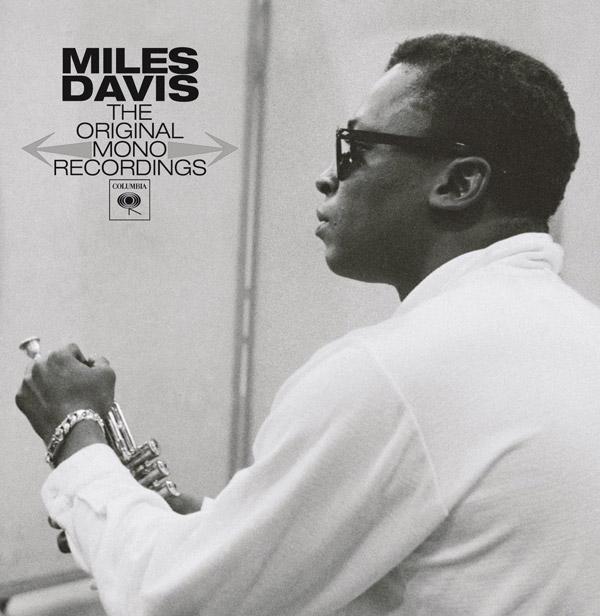| Columns Retired Columns & Blogs |
The artwork for this collection is odd, in that they're using the "stereo arrows" around the word "MONO".

But the latest excavation from the Miles Davis archive, The Original Mono Recordings, nine CDs of the nine albums made for Columbia from 1955–63, is an exception, a set worthy of attention—though not so much because the discs are in mono.
The value of this boxed-set is that Columbia Legacy's chief engineer, Mark Wilder, has gone through all the master tapes (the "A" reels and the "B" backups), picked the better version of each track on each album (sometimes it turned out to be the B), then compared it with the track on an original mono LP, and dialed in tweaks (EQ, frequency balance, compression, etc.) to make the tape sound as much as possible like the vinyl. (Tape ages; a pristine LP doesn't.)
As a result, most of the albums in this set—Round About Midnight, Miles Ahead, Milestones, Jazz Track (which includes the soundtrack of
There are exceptions. Kind of Blue sounds about the same as the stereo CDs, because it's mixed down from the same 3-track tape (the mono masters are, by some accounts, worn out; by other accounts, missing). And, as a personal taste, I prefer orchestral recordings—Porgy, Sketches, and Miles Ahead, all done with Gil Evans—spread out.
But even those big-band albums have some advantages because of Wilder's tweaking. Most of all, the bass is much clearer and thwackier; the mono remastering brings alive a whole rhythmic layer that hasn't been so audible in any reissue, analog or digital (except for the audiophile LP pressings by Classic Records, Acoustic Sounds, and Mobile Fidelity).
Wilder tells me in an email that he did his tape-to-vinyl comparisons using a 9-input monitor preamp with level adjustments. His other gear included Duntech Princess speakers, a Krell FPB-300 amp, and a Denon DP 72L turntable with a Shure V15 cartridge and Bryston phono stage. He heard the tape on an Ampex ATR, or Studer reel-to-reel, whichever sounded better.
The set's booklet contains Wilder's mastering notes for each album. Here's what he wrote about Miles Ahead: "Surprisingly, the original master was in very good shape. But when we listened to the master on the playback machine, it sounded a little thin and hard compared to the original album pressing. So we used a softer-sounding tube equalizer to standardize the bass and reduce the mid-range throughout." (That, by the way, sums up the sonic difference between this CD of Miles Ahead and previous digital reissues, including one that Wilder mastered.)
For Sketches of Spain: "The sound was even throughout and compared well to the original LP. The only equalization was a small adjustment in the bass to achieve the same tonal quality in the bottom few octaves that existed on the original mono LP."
It's this kind of care that you hear on this boxed set. And, of course, the music is some of the greatest jazz ever.

The artwork for this collection is odd, in that they're using the "stereo arrows" around the word "MONO".

Glad to hear that they are still improving these historic recordings. I like the 2006 reissues done by Wilder for Sony Japan, with Someday My Prince Will Come DSD as one of the best sounding albums I own. It would be a big ask for the new monos to sound even better. Is it an unfair comparison due to the DSD format of the previous reissue?

Overall, I'm thrilled with this set. I have, however noticed one thing that seems to be an error in the remastering process of MILES AHEAD, and I'm wondering if anyone with expertise or "inside knowledge" might be able to enlighten me. In the second bar of Miles Ahead, after the closing sustain held over from My Ship, there is a sudden increase in volume. The first bar of Miles Ahead is at a volume level consistent with the ending of My Ship, but in the second bar, it abruptly seems to get almost twice as loud. This doesn't occur on any previous CD release of this album, including the Complete Columbia Studio Sessions box. Was this present on the original mono LP, or a mastering oversight that was missed until after the CD's were pressed? Unfortunately, I find it really distracting and artificial sounding, and I find it takes away from the experience of listening to the album. Anybody else notice this, or have any thoughts about it?

I am thankful for this great and insightful article, however there is one KEY detail missing that I would absolutely like to know. Is the vinyl version of this box set done entirely in the analog domain. meaning, It was from the tape so source is analog but was it mastered in analog and cut without a digital lookback head on the lathe. Essentially I would like to know if there was any digital inserted to the signal chain in the making of the vinyl version of this box set. I would really like to know this information and hope that you have time to reply to this. I feel that this information is critical for any release/review of an item available on vinyl. Thank you.